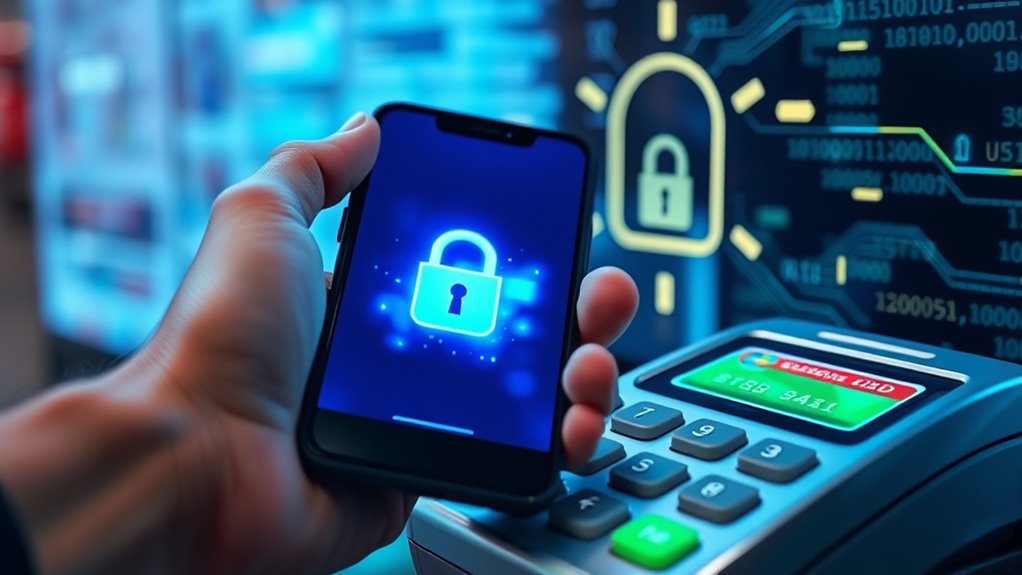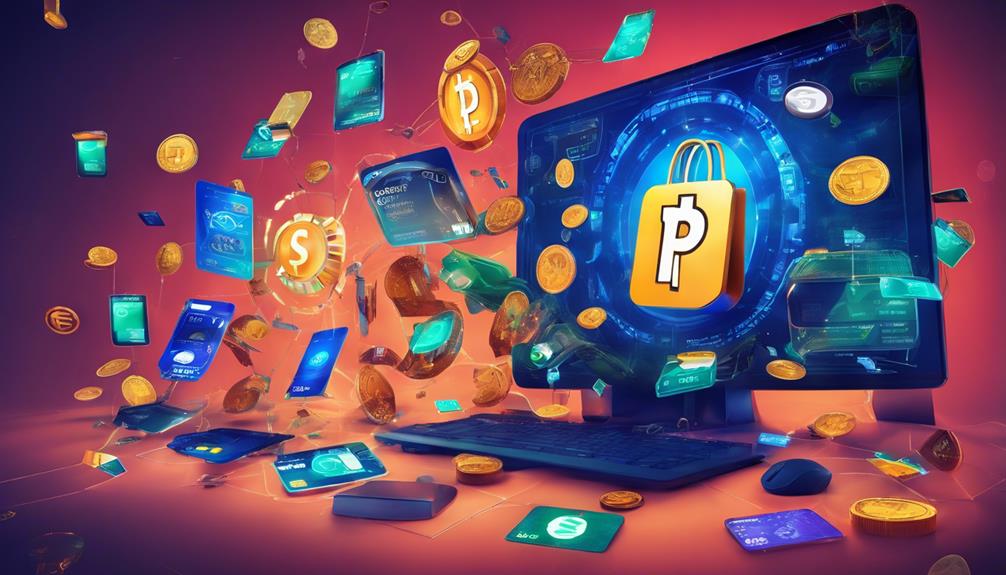Tokenization and encryption both protect your payment data, but they work differently. Tokenization replaces sensitive info with nonsensitive tokens stored securely, so your original data stays isolated, reducing breach risks. Encryption transforms your data into unreadable ciphertext that can be reversed with the right keys, ensuring confidentiality during storage and transmission. Understanding how these methods work together helps keep your payment information safer—continue exploring to learn more about securing your data effectively.
Key Takeaways
- Tokenization replaces sensitive payment data with nonsensitive tokens, removing actual info from systems to reduce breach risk.
- Encryption converts payment data into unreadable ciphertext, protecting it during storage and transmission, and is reversible with keys.
- Tokenization minimizes sensitive data exposure, simplifying PCI compliance, while encryption ensures confidentiality during data transit and storage.
- Tokens cannot be reversed without access to a secure vault, whereas encrypted data can be decrypted using cryptographic keys.
- Combining tokenization and encryption provides layered security, safeguarding payment data throughout its lifecycle.

Are you wondering how to best protect sensitive data in your organization? Understanding the differences between tokenization and encryption is essential for developing a solid security strategy. Both methods help safeguard your data, but they do so in different ways and serve distinct purposes.
Tokenization replaces sensitive information with nonsensitive tokens, which act as stand-ins for the original data. These tokens look similar to the real data but hold no actual value. The original data remains securely stored in a separate vault, making it inaccessible without proper authorization. This approach markedly reduces the risk of data breaches because your sensitive data isn’t handled or exposed during transactions or storage. It’s especially useful for card-on-file payments and recurring transactions, where it helps simplify PCI DSS compliance by removing sensitive information from your environment. Since tokens preserve the original data format, they’re ideal for structured data like credit card numbers, making integration smoother without altering how your systems process information. Implementing robust safety measures is essential, especially given that research indicates vulnerabilities to jailbreaking techniques in AI models.
Tokenization replaces sensitive data with non-sensitive tokens, simplifying PCI compliance and reducing breach risks.
In contrast, encryption transforms plaintext data into unreadable ciphertext using cryptographic algorithms and keys. This process ensures your data remains confidential both when stored (at rest) and when transmitted over networks (in transit). Encryption is essential for protecting data during in-person transactions or when transmitting sensitive information over public networks. To access the original data, authorized users need the decryption key, making it a reversible process. This reversibility means encryption is often used when the data must be processed or viewed in its original form, like during detailed reporting or in live transaction environments.
While both techniques enhance security, their approaches differ. Tokenization replaces data with tokens that cannot be reversed without access to the vault, effectively isolating sensitive data. Encryption, on the other hand, scrambles data into ciphertext that can be decrypted with the correct key, allowing authorized users to recover the original information. Tokenization primarily secures data at rest, reducing the scope of sensitive information handled within your environment. Encryption protects data both at rest and in transit, ensuring confidentiality during transmission and storage.
Using both techniques together can offer layered security, maximizing your protection. You might tokenize card data to minimize PCI scope and encrypt it during transmission or processing to maintain confidentiality. This combined approach provides a complete security posture, safeguarding your organization against a wide range of threats and helping you meet regulatory requirements effectively.
Frequently Asked Questions
Can Tokenization Replace Encryption Entirely?
You might wonder if tokenization alone can fully protect your data. While it masks sensitive information by replacing it with tokens, it doesn’t secure data during transmission or when processing. Relying solely on tokenization leaves vulnerabilities, especially if the token vault is compromised. To truly safeguard your data, it’s crucial to combine tokenization with encryption, ensuring thorough security both at rest and in transit.
Which Method Is Faster for Real-Time Transactions?
You’re wondering which method speeds up real-time transactions. Tokenization is typically faster because it involves smaller, simpler data and less computational overhead, resulting in quicker processing. Encryption, while secure, demands more resources for encrypting and decrypting data, which can slow things down, especially under high loads. So, if speed is your priority, tokenization usually offers better performance for real-time payment authorization.
Are Both Methods Compliant With PCI DSS Standards?
You’re asking if both methods meet PCI DSS standards. Yes, they do, but with conditions. Tokenization can reduce scope if implemented correctly, keeping primary account numbers out of your environment. Encryption must use strong algorithms and strict key management to stay compliant, but encrypted data still counts as cardholder data. Both require secure networks and controls, so ensuring proper setup is essential for PCI DSS compliance.
How Do Tokenization and Encryption Impact User Experience?
You’ll notice that tokenization often makes your experience smoother, especially for recurring payments, since stored tokens mean fewer re-entries. It also keeps sensitive info hidden, boosting your confidence. Encryption, on the other hand, requires decryption for viewing or processing, which can slow things down slightly. While both methods protect your data, tokenization offers more convenience for quick, repeated transactions, enhancing your overall user experience.
What Are the Long-Term Costs of Implementing Each Security Method?
Imagine planting a sturdy tree; its roots represent your long-term security costs. For tokenization, you face high upfront costs like planting the seed, but enjoy lower maintenance, like pruning and watering. Encryption’s costs are like caring for a delicate bonsai, with ongoing expenses for pruning and updates. Over time, both methods require investment, but tokenization can reduce operational expenses, while encryption demands continuous attention to stay resilient against evolving threats.
Conclusion
So, now that you understand how tokenization and encryption protect your payment data, you can see they each play crucial roles in security. While encryption scrambles your info, tokenization replaces sensitive details with tokens, making it even safer. Isn’t it reassuring to know your data is guarded by these powerful tools? Staying informed helps you make smarter choices—after all, isn’t peace of mind worth every effort? Keep these methods in mind next time you pay online.









